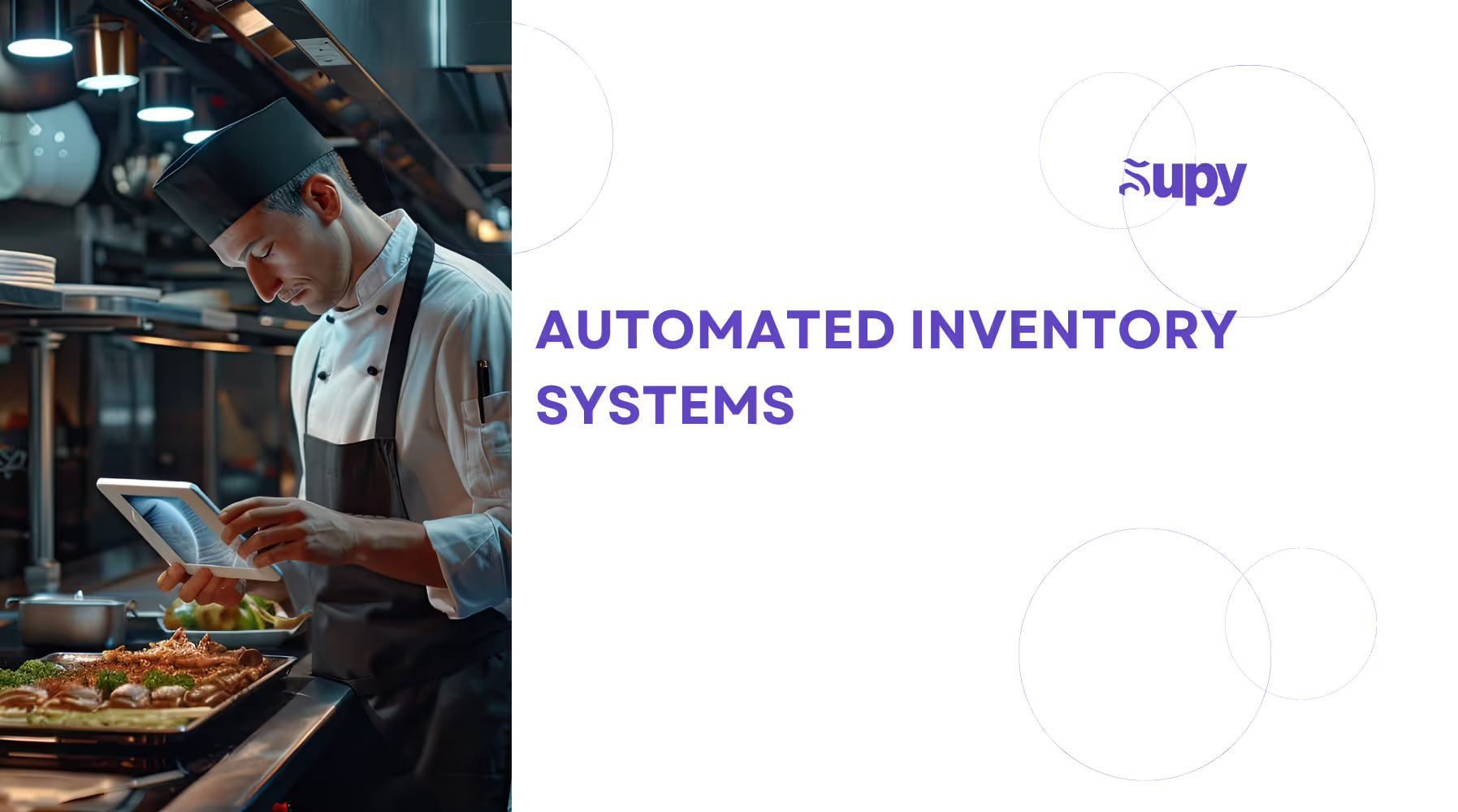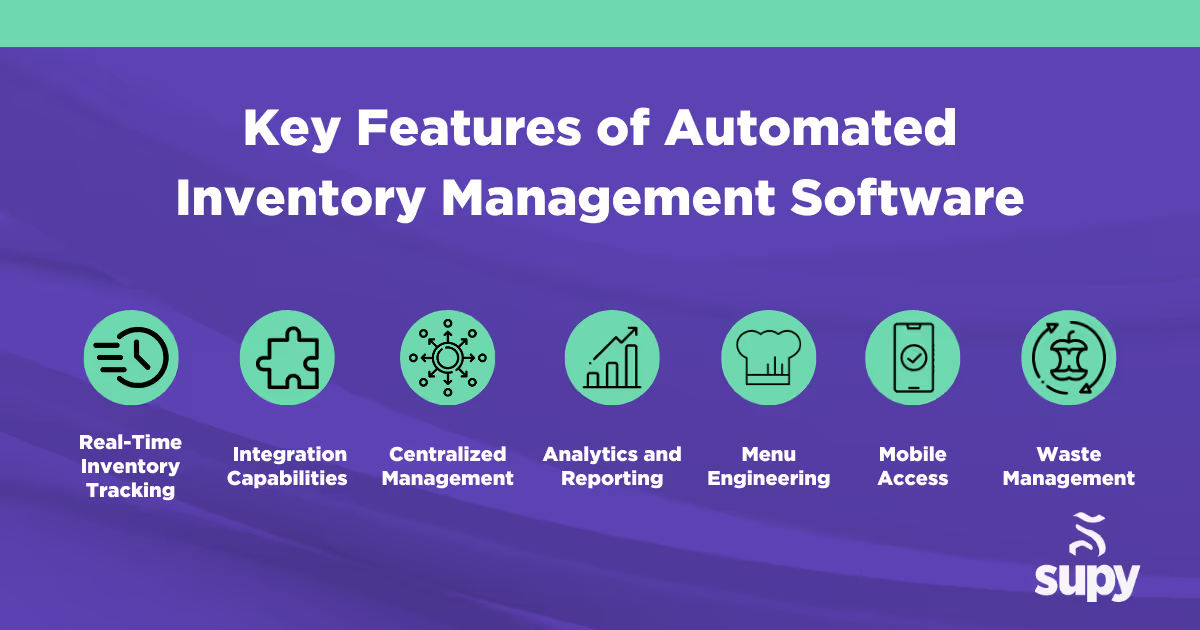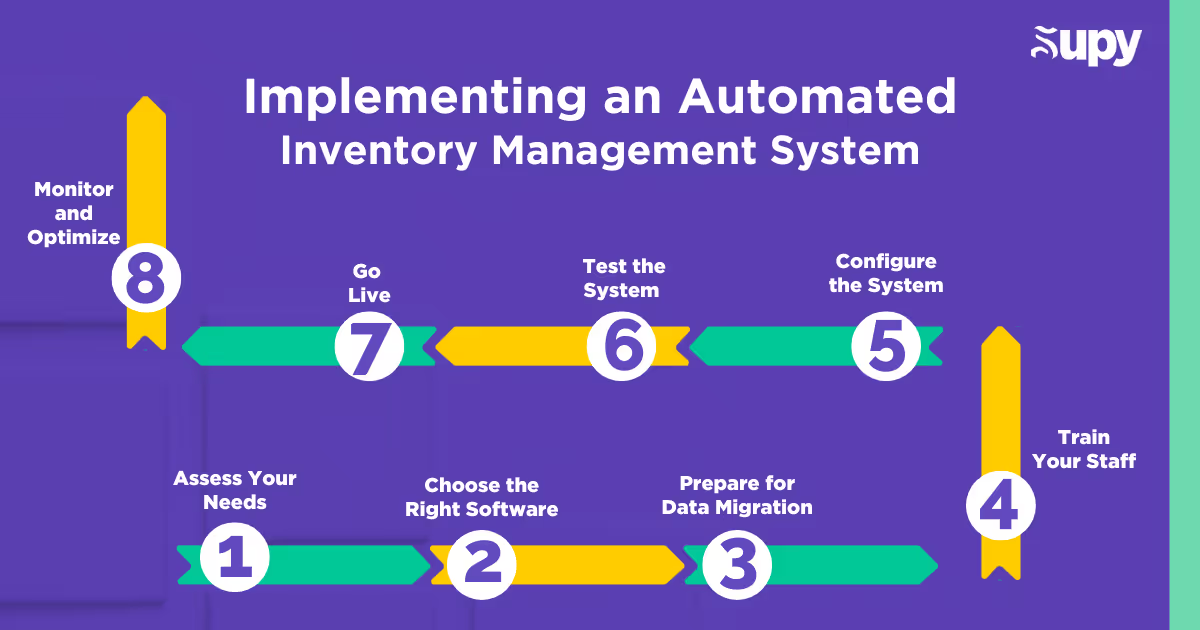Automated Inventory Systems: Guide to Streamlining Restaurant Operations

Running a restaurant involves juggling countless tasks, from managing staff to ensuring the quality of food served. One of the most critical yet often overlooked aspects of business operations is inventory management.
Accurate inventory control is essential for minimizing waste, reducing costs, and maintaining smooth operations. However, manual inventory management processes can be time-consuming and prone to human error.
This is where automated inventory systems come into play. According to the National Restaurant Association, adopting technology in inventory management can reduce food waste by up to 30%. By automating these processes, restaurants can ensure they always have the right amount of stock on hand, avoiding both shortages and excess.
- How Automated Inventory Management Systems Work?
- Benefits of Automating Your Inventory Management
- Key Features of Automated Inventory Management Software
- Implementing an Automated Inventory Management System
- Conclusion
- About Supy
By understanding and implementing automated inventory systems, you can significantly improve your restaurant's operations and bottom line.
1. How Automated Inventory Management Systems Work?
Automated inventory management systems collect data throughout the fulfillment process and transform it into actionable business intelligence. In the restaurant industry, these systems integrate with the point-of-sale (POS) system to automatically update stock levels whenever an item is sold.
This seamless integration ensures that real-time inventory data is always current, reducing the risk of overstocking or running out of essential ingredients. For example, when a customer orders a dish, the POS system instantly records the sale and adjusts the inventory accordingly.
Barcode scanners and RFID technology further monitor stock as it moves through the supply chain. This level of inventory automation allows restaurant managers to see exactly how much inventory is on hand and what needs to be reordered, helping to prevent issues like theft or wastage. This real-time insight enables restaurants to respond quickly to changes in demand, maintain efficient operations, and ensure timely order fulfillment.
2. Benefits of Automating Your Inventory Management

Automating inventory management in restaurants offers numerous advantages that enhance efficiency, reduce costs, and improve overall operations. Here are some of the top benefits:
- Significant Time Savings: Automated systems can decrease the time spent on inventory management tasks allowing staff to focus on other critical areas such as customer service and food preparation. This ability to save time enhances overall productivity and service quality.
- Reduction in Food Costs: Restaurants using automated inventory systems report an average reduction in costs by 5-10%. This is due to more accurate insights into food usage and waste, which help in making better purchasing decisions. Improved supply chain management ensures optimal stock levels, reducing unnecessary expenses.
- Improved Inventory Accuracy: Automation reduces human errors common in manual tracking. Technologies like barcode scanning and RFID tags ensure precise tracking of inventory levels, maintaining consistency and accuracy. This leads to better demand forecasting and more efficient inventory automation.
- Real-Time Inventory Monitoring: Automated systems provide real-time data on stock levels, preventing stockouts and overstock situations. This ensures that essential ingredients are always available, optimizing stock levels and contributing to customer satisfaction.
- Enhanced Decision-Making with Data Analytics: By analyzing sales trends and inventory usage, automated systems offer valuable insights that help in making informed decisions about menu changes, pricing strategies, and purchasing schedules. This data-driven approach improves overall business operations.
- Labor Cost Savings: Automation of repetitive tasks allows restaurants to reduce labor costs by redirecting staff to more complex tasks that require human intervention. This improvement in labor allocation increases overall productivity and efficiency, further enhancing customer satisfaction.
3. Key Features of Automated Inventory Management Software

Automated inventory management solution offers a range of features specifically designed to address the challenges faced by the restaurant industry. These features enhance operational efficiency, reduce costs, and improve overall business performance.
1. Real-Time Inventory Tracking
Real-time inventory tracking continuously monitors stock levels, updating them automatically with each sale or delivery. This feature is crucial for preventing both stockouts and overstock situations.
Without real-time tracking, restaurants might run out of key ingredients during peak hours or waste money on excess inventory that spoils before use. This constant visibility helps in making timely decisions and maintaining an uninterrupted service flow.
2. Integration Capabilities
Integration with existing systems such as POS (Point of Sale), accounting software, and supplier networks is essential for seamless operations. This feature ensures that data flows smoothly across different platforms, reducing manual data entry and the risk of errors. By integrating with multiple sales channels, restaurants can centralize inventory data, making it easier to manage and analyze.
Integration capabilities allow for automatic updates of inventory levels with sales data, syncing financial records, and streamlining the reordering process. For example, when the POS system records a sale, the inventory is automatically adjusted, providing real-time insights and reducing the workload for staff. Managing inventory across multiple sales channels ensures consistency and accuracy, enhancing overall efficiency.
3. Centralized Management
Centralized management consolidates inventory data from all locations into a single system, which is essential for multi-branch restaurant chains. This feature simplifies the management of inventory transfers, bulk purchasing, and overall inventory control across multiple sites. By integrating warehouse management, restaurants can streamline stock handling and distribution processes, ensuring all branches are adequately supplied.
It ensures consistency in operations, helps maintain unified standards, and facilitates better decision-making at the corporate level. Comprehensive reporting and analytics provided by centralized management offer a holistic view of the business’s inventory performance. This includes detailed insights into warehouse management, which supports efficient stock replenishment and optimized inventory levels across all locations.
4. Analytics and Reporting
Advanced analytics and reporting tools provide deep insights into inventory usage, sales trends, and cost analysis. These tools help restaurant managers understand which items are selling well and which are not, allowing them to adjust their menus and purchasing strategies accordingly. Detailed reports highlight patterns and anomalies, helping to optimize stock levels, forecast demand, and identify cost-saving opportunities. This data-driven approach enables better strategic decisions that enhance profitability and operational efficiency.
5. Menu Engineering
Menu engineering analyzes the profitability of individual menu items by linking inventory data with menu pricing. This feature helps restaurants determine which items generate the most profit and which ones may need adjustments.
By understanding the cost and popularity of each dish, managers can optimize their menu to focus on high-margin items, ultimately improving the restaurant’s bottom line. Menu engineering also aids in dynamic pricing strategies, ensuring that menu prices reflect current costs and market demand.
6. Mobile Access
Mobile access allows restaurant managers to monitor and manage inventory from anywhere, providing flexibility and improving responsiveness. This feature is particularly useful for multi-branch operations or managers who are frequently off-site.
It ensures that inventory data is always at hand, enabling quick decision-making and timely interventions. It also facilitates remote audits and real-time updates, ensuring that inventory management is not confined to the back office.
7. Waste Management
Effective waste management tracks discrepancies between expected and actual inventory usage, identifying areas where waste occurs. This feature helps in pinpointing overproduction, spoilage, theft, and other inefficiencies.
By addressing these issues, restaurants can significantly reduce waste, leading to cost savings and more sustainable operations. Automated waste management systems provide actionable insights that help managers implement corrective measures, such as adjusting portion sizes or improving storage practices.
4. Implementing an Automated Inventory Management System

Implementing an automated inventory management system in your restaurant involves several crucial steps. These steps will help ensure a smooth transition from manual processes to an efficient, automated system. Here’s how you can successfully implement this system:
1. Assess Your Needs
Start by thoroughly evaluating your restaurant's specific needs. Consider the following questions to guide your assessment:
- How large is your inventory, and how frequently does it turn over?
- Do you have multiple branches, and how do you currently manage inventory across them?
- What are your biggest pain points with your current inventory management process?
- What specific outcomes do you want to achieve with the new system (e.g., reducing waste, improving accuracy, saving time)?
This detailed assessment will help you understand what features you need in an inventory management system and will guide you in selecting the right one for effective inventory management.
2. Choose the Right Software
When you choose inventory management software, look for key features such as real-time inventory tracking, integration capabilities, analytics and reporting, menu engineering, mobile access, waste management, and centralized management. Weigh these features against your specific needs to find the best fit for your restaurant.
For instance, Supy offers a comprehensive inventory management solution tailored for the hospitality industry. It combines real-time data analytics with user-friendly features, helping restaurants cut costs, reduce waste, and maximize profits.
Book a demo to find out more about how automated inventory management can transform your restaurant operations.
3. Prepare for Data Migration
Data migration is a crucial step in implementing a new inventory management system. Start by gathering all existing inventory data, including stock levels, supplier information, and historical sales data. Cleansing this data is essential—remove inaccuracies or duplicates to ensure reliability. This process sets a strong foundation for your new system.
Organize the data logically, aligning it with the new system’s structure to facilitate easy import. Pay attention to key performance indicators (KPIs) such as turnover rates, cost of goods sold (COGS), and stock accuracy. Proper data migration ensures that your new inventory management system operates smoothly from the start, providing you with reliable insights and a solid base for future operations.
4. Train Your Staff
Training your staff is crucial to ensure effective use of the new system. Start with comprehensive training sessions that cover all aspects of the system, from data entry to report generation. Hands-on training methods help staff become comfortable with the new system, ensuring they can navigate it confidently.
Additionally, provide ongoing support through user manuals, video tutorials, and help desks. Regular refresher courses can also be beneficial, especially when updates or new features are introduced. This ensures a smooth transition and maximizes the system's benefits by empowering staff to use the software efficiently and understand the entire workflow.
5. Configure the System
Configuring the software to match your restaurant's needs involves several steps. Begin by setting up inventory categories, reorder points, and other settings based on your workflows. This customization aligns the system with your processes, ensuring it meets all operational requirements.
Next, integrate the software with existing systems like POS and accounting software for seamless data flow. Proper configuration optimizes the system's efficiency from day one, enabling streamlined operations and accurate inventory management. This integration also helps automate processes and improve vendor relations.
6. Test the System
Conduct thorough testing before full implementation. Test the integration with your POS system to confirm accurate data syncing and verify the accuracy of real-time tracking and reports. Identifying and resolving issues during this phase is crucial to prevent operational disruptions.
Address any problems found during testing and make necessary adjustments. This pre-launch phase ensures the system operates smoothly when it goes live, reducing the risk of errors and ensuring all features function as intended.
7. Go Live
Once testing is complete, go live with the system. Start using it for daily inventory management tasks, monitoring closely during the initial phase to ensure proper functioning. Encourage staff to provide feedback and make adjustments based on their experiences.
A successful go-live phase sets the stage for long-term success with the new system. Continuous monitoring during this period helps fine-tune the system and address any initial issues promptly.
8. Monitor and Optimize
Continuous monitoring and optimization are key to maintaining an efficient system. Use analytics and reporting features to track inventory levels, sales trends, and waste. Regularly review data to identify areas for improvement and optimize the system.
Stay updated with software updates to take advantage of new features and improvements. Ongoing monitoring ensures the system continues to meet your needs and delivers maximum benefits. Regular assessment and optimization help maintain efficiency in your business operations and inventory management.

5. Conclusion
Automating your restaurant's inventory management can transform your operations, providing significant benefits such as time savings, reduced costs, improved accuracy, and enhanced decision-making. By implementing an automated inventory system that integrates seamlessly with existing technologies and processes, you can streamline workflows, minimize waste, and ensure that your restaurant runs smoothly and efficiently. Embrace these technological advancements to stay ahead in the competitive restaurant industry, and watch as your operational efficiency and profitability soar.
6. About Supy
Supy is an advanced inventory management solution designed for the hospitality industry. By automating crucial inventory processes, Supy provides real-time alerts on stock levels, usage patterns, and reorder needs. This helps restaurants cut costs, reduce waste, and maximize profits. The software's user-friendly interface and comprehensive features ensure that you can streamline your operations and maintain optimal inventory levels across all locations.
Schedule a demo today to learn more about how Supy can transform your restaurant operations and drive your business forward.






